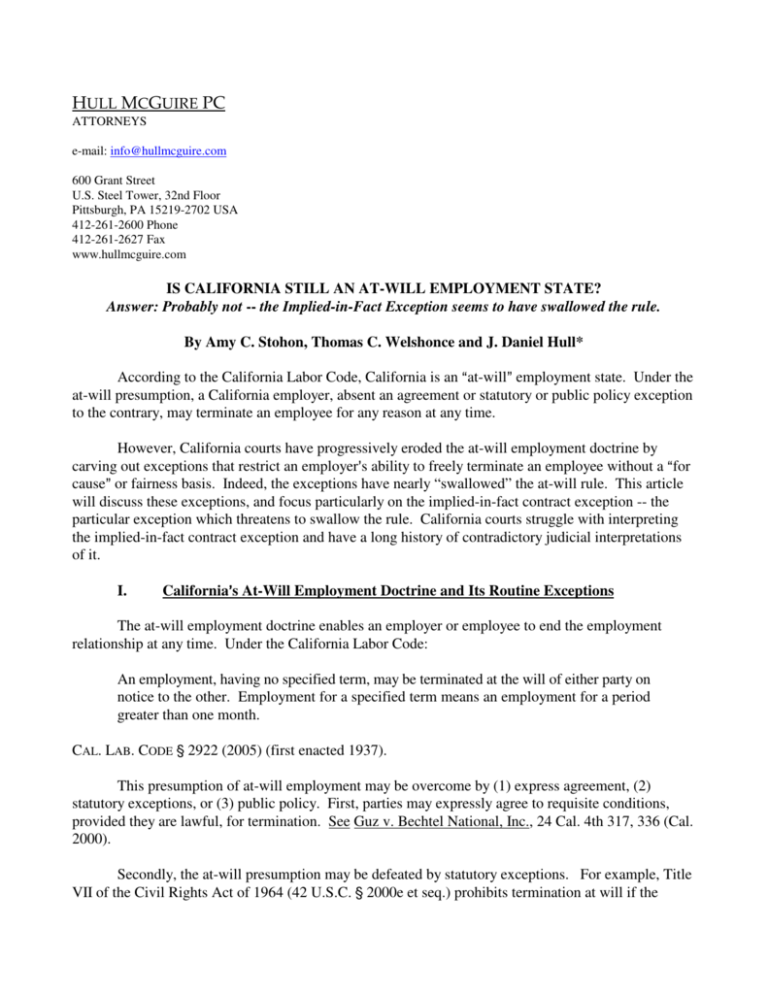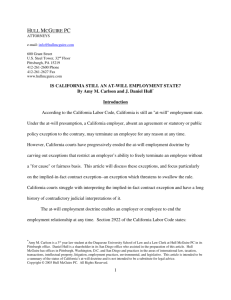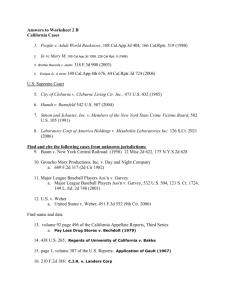
HULL MCGUIRE PC
ATTORNEYS
e-mail: info@hullmcguire.com
600 Grant Street
U.S. Steel Tower, 32nd Floor
Pittsburgh, PA 15219-2702 USA
412-261-2600 Phone
412-261-2627 Fax
www.hullmcguire.com
IS CALIFORNIA STILL AN AT-WILL EMPLOYMENT STATE?
Answer: Probably not -- the Implied-in-Fact Exception seems to have swallowed the rule.
By Amy C. Stohon, Thomas C. Welshonce and J. Daniel Hull*
According to the California Labor Code, California is an Aat-will@ employment state. Under the
at-will presumption, a California employer, absent an agreement or statutory or public policy exception
to the contrary, may terminate an employee for any reason at any time.
However, California courts have progressively eroded the at-will employment doctrine by
carving out exceptions that restrict an employer=s ability to freely terminate an employee without a Afor
cause@ or fairness basis. Indeed, the exceptions have nearly “swallowed” the at-will rule. This article
will discuss these exceptions, and focus particularly on the implied-in-fact contract exception -- the
particular exception which threatens to swallow the rule. California courts struggle with interpreting
the implied-in-fact contract exception and have a long history of contradictory judicial interpretations
of it.
I.
California==s At-Will Employment Doctrine and Its Routine Exceptions
The at-will employment doctrine enables an employer or employee to end the employment
relationship at any time. Under the California Labor Code:
An employment, having no specified term, may be terminated at the will of either party on
notice to the other. Employment for a specified term means an employment for a period
greater than one month.
CAL. LAB. CODE ' 2922 (2005) (first enacted 1937).
This presumption of at-will employment may be overcome by (1) express agreement, (2)
statutory exceptions, or (3) public policy. First, parties may expressly agree to requisite conditions,
provided they are lawful, for termination. See Guz v. Bechtel National, Inc., 24 Cal. 4th 317, 336 (Cal.
2000).
Secondly, the at-will presumption may be defeated by statutory exceptions. For example, Title
VII of the Civil Rights Act of 1964 (42 U.S.C. ' 2000e et seq.) prohibits termination at will if the
termination is based on protected status such as race or ethnicity. Similarly, the National Labor
Relations Act (29 U.S.C. ' 151 et seq.) forbids firing for engaging in union and protected concerted
activity, and for filing charges and testifying under the Act. See Foley v. Interactive Data Corp., 47
Cal. 3d 654, 665 n.4 (Cal. 1988).
Finally, public policy exceptions have been found to preclude termination at will. For example,
an employee cannot be terminated by his employer for refusing to engage in illegal price fixing in
violation of the Sherman Antitrust Act and the Cartwright Act. See Tameny v. Atlantic Richfield Co.,
27 Cal. 3d 167 (Cal. 1980).
Despite their power to transform an at-will employment relationship into one for cause, these
three exceptions are fairly routine. They are not difficult for courts, employers or employees to apply.
However, California courts also recognize a fourth exception: the implied-in-fact contract. This
exception has not only greatly hamstrung managerial discretion in the workplace, but has also created
much confusion in the courts.
II.
The Implied-In-Fact Exception to the At-Will Employment Doctrine
In the 1980=s, California courts decided two key cases that applied the implied-in-fact
exception to the employment arena: Pugh v. See=s Candies, Inc., 171 Cal. Rptr. 917 (Cal. Ct. App.
1981) (overruled in part by Guz, 24 Cal. 4th 317, 351) and Foley, 47 Cal. 3d at 654.
A.
Pugh v. See==s Candies, Inc.: ATotality of the Circumstances@@
In Pugh, the appellant employee worked his way up the corporate ladder from dishwasher to
vice president, and was fired after 32 years of employment. Pugh, 171 Cal. Rptr. at 918. In a breach of
employment contract action against his employer and the union, Pugh alleged he was discharged for
objecting to his employer=s various proposals to modify its contract with the union. Id. at 920. Pugh
argued that he was wrongfully terminated because his employer frequently assured him of job security;
maintained a practice of not firing administrative personnel except for good cause; never notified him
of a problem that he needed to correct; never formally criticized his work; and never denied him a
bonus. Id. at 919-20.
The trial court granted the defendants’ motions for nonsuit, and the California Court of
Appeals, relying on contract principles, reversed. The appellate court held that though Pugh and his
employer had not expressly agreed to a for cause employment relationship, nonsuit was improper since
a jury could conclude from the factual evidence that the employer impliedly promised to refrain from
treating his employees in an arbitrary manner. Id. at 927. In particular, the court explained that an
implied-in-fact contract can arise from such factors as the employer=s acknowledged policies and
practices, the longevity of the employee=s service, promotions, assurances, and absence of direct
criticism. Pugh, 171 Cal. Rptr. at 927. However, the court cautioned that the totality of the
employment relationship -- not just abstract language standing alone -- must first be scrutinized in
order to determine whether the parties had formed an implied-in-fact contract. Id.
Page 2 of 7
B.
Foley v. Interactive Data Corp.: AActual Intent@@ and New Factors
Seven years later, in Foley v. Interactive Data Corp., 47 Cal. 3d 654 (Cal. 1988), the California
Supreme Court affirmed Pugh, but expanded the types of situations in which the implied-in-fact
contract exception could apply. Specifically, the court reiterated that implied-in-fact agreements are
proven by fact-based arguments, applying a Atotality of the circumstances@ approach to the parties=
conduct. Foley, 47 Cal. 3d at 681. In Foley, the plaintiff employee received steady salary increases,
promotions, awards, and excellent performance evaluations during his 6 years and 9 months of
employment. Id. at 663. The company decided to replace Foley for Aperformance reasons@ shortly
after he voiced his suspicions that his new supervisor previously engaged in criminal activity. Id. at
664. Ultimately, Foley was given the choice to either resign or be fired. Id.
Foley first argued that he was discharged in violation of public policy. However, the appellate
court held that when an employee chooses to disclose information to his employer that serves only the
employer=s private interest and not the public interest at-large, the public policy exception does not
apply. Foley, 47 Cal. 3d at 662. On appeal, the California Supreme Court affirmed this portion of the
appellate court=s holding, which dismissed Foley=s causes of action alleging a discharge in breach of
public policy and a tortious breach of the implied covenant of good faith and fair dealing. Id. at 670671.
However, more importantly, the court reversed the portion of the lower court’s judgment that
dismissed Foley=s cause of action alleging an implied-in-fact agreement to discharge only for cause. In
response to Foley=s implied-in-fact contract argument, the court determined, as in Pugh, that Foley had
plead facts which, if proven, could lead a jury to find that he and his employer formed an implied-infact contract that limited his employer=s ability to arbitrarily discharge him. Id. at 681-682. The court
identified several factors that may prove the existence of an implied agreement to only terminate for
cause. Those factors include personnel policies, employer practices, industry practices, employee=s
length of service, and assurances by the employer of continued employment. Id. at 679-680. In
identifying these factors, the court reasoned that in employment cases, the fact finder needs to
determine the parties= actual intent, and in order to do so, can examine the parties= conduct to see if they
created an implied contract. Id.
C.
Scott v. Pacific Gas & Electric Co.: ADemotions Protected@@
Following Foley, the California Supreme Court in Scott v. Pacific Gas & Electric Co., 11 Cal.
4th 454 (Cal. 1995), significantly expanded the implied-in-fact contract exception to cover wrongful
demotions as well. In Scott, the plaintiff employees were demoted from senior managerial engineering
positions, and sued, claiming, among other things, that their employer breached an implied-in-fact
contract term to demote employees only for good cause. Scott, 11 Cal. 4th at 458.
On appeal, the California Supreme Court reinstated the trial court=s decision to award the
employees damages arising from the employer=s breach of an implied-in-fact contract term to only
Page 3 of 7
demote employees for good cause. Id. at 474. In analyzing the plaintiffs= claim, the Scott court
referred to Foley and pointed out the modern trend in contract law to reverse the presumption that the
writing provides the definitive terms of the agreement, and stated that evidence from experience and
practice can create new terms to an agreement. Id. at 463. The court quoted the Foley court language
that Aimplied contractual terms >ordinarily stand on equal footing with express terms.=@ Scott, 11 Ca.
4th at 463 (quoting Foley, 47 Cal. 3d at 677-78).
The court concluded that the employees’ claims based on an implied-in-fact contract term to
demote only for cause should stand. The court noted “ample evidence” from the employer’s personnel
policy manual and testimony of one of the employer’s managers to support the view that the employees
had a reasonable expectation that the employer would follow its own human resources policy, which
stated that disciplining of employees would only occur for good cause. Id. at 465.
III.
What==s the Problem with the Implied-In-Fact Exception?
Pugh, Foley, and Scott each advocated a Atotality of the circumstances@ approach, and set out a
seemingly straightforward standard for determining the existence of an implied-in-fact contract.
California courts, however, struggle greatly in applying this guideline. In fact, California case law
applying the standard is inconsistent: see Wayte v. Rollins International, Inc., 169 Cal. App. 3d 1, 18
(Cal. Ct. App. 1985) (in wrongful discharge action, evidence of employer=s repeated assurances over
six years that employee=s work was satisfactory was sufficient to raise inference that employee was
wrongfully terminated in violation of an implied-in-fact promise that he would only be discharged for
cause); Harlan v. Sohio Petroleum Co., 677 F. Supp. 1021, 1030 (N.D.Cal. 1988) (in plaintiff=s action
for breach of contract and wrongful discharge, court denied defendant employer=s summary judgment
motion because evidence that defendant made oral assurances about job security to plaintiff during
recruitment raised genuine issue of material fact of whether employer=s discharge of plaintiff was
wrongful breach of an implied promise not to terminate except for good cause); Miller v. Pepsi-Cola
Bottling Co., 210 Cal. App. 3d 1554, 1559 (Cal. Ct. App. 1989) (court affirmed trial court=s grant of
summary judgment for employer in wrongful discharge action and held that mere promotions and
salary increases during eleven years of service were natural occurrences of employment relationships
insufficient to raise the inference of an implied-in-fact contract); and Tollefson v. Roman Catholic
Bishop, 219 Cal. App. 3d 843, 856 (Cal. Ct. App. 1990) (summary judgment for employer in wrongful
discharge action was proper where employer and employee had express one-year agreement with no
obligation for renewal, holding terms of written agreement cannot be changed through evidence of long
service, prior contract renewals, and absence of poor performance evaluations).
Courts appear uncertain as to whether at-will disclaimers in employment manuals and
handbooks, oral assurances of job security and continued employment, performance appraisals,
promotions, salary increases, and a combination of some or all of these factors are enough to transform
an at-will relationship into one for cause. In fact, these contradictory outcomes even led one judge of
the U.S. Court of Appeals for the Ninth Circuit to reflect that the once simple presumption of at-will
employment has been replaced by burdensome trials and discovery, has created endless and
insurmountable confusion among judges and juries, and has withered away to a Ahollow legal fiction.@
Page 4 of 7
See Kern v. Levolor Lorentzen, Inc., 899 F.2d 772, 783 (9th Cir. 1990) (Kozinski, J., dissenting)
(questioned on other grounds by Guz, 24 Cal. 4th 317).
Much of the problem stems from the fact that, despite the stated resolve to abide by traditional
contract law, California courts are veering from this goal. For instance, although contract law requires
that parties manifest an intent to be bound by an agreement, courts are confused as to what factors
demonstrate intent, as highlighted in Foley. Deciphering what the parties intended is no easy task -especially since the Foley court explained that the contractual understanding need not be overt, but can
arise from the parties= conduct. Foley, 47 Cal. 3d at 679-680. However, a significant discrepancy
results when some California courts find the requisite contractual intent solely based on employer
praise and promotion in response to satisfactory employee performance, while other courts require
these factors plus much more.
Consequently, employers haven=t the slightest idea of how to protect themselves from impliedly
entering into “for cause” employment relationships. Since California courts insist on examining the
Atotality of the circumstances@ (see, e.g., Pugh, Foley, and Scott), at-will disclaimers in employment
handbooks and manuals provide little protection. Likewise, though employers could have their
employees sign written, express agreements that specifically indicate that the employees work at-will,
these too are only one factor for consideration in the Atotality@ approach. However, a few recent
California cases significantly eliminated past confusion by enunciating what steps an employer can
take to ensure that at-will remains the rule in the workplace.
IV.
Clarity for California Employers?
The Pugh line of cases analyzes the employment relationship based on the Atotality of the
circumstances.@ However, in Guz, the California Supreme Court stressed that the Atotality of the
circumstances@ analysis should not imply Athat every vague combination of Foley factors, shaken
together in a bag, necessarily allows a finding that the employee had a right to be discharged only for
good cause, as determined in court.@ Guz, 24 Cal. 4th at 337.
Even though employers may attempt to protect themselves by including at-will provisions in
employment handbooks and personnel manuals, California courts still allow other evidence of contrary
employment intent, especially when other provisions in the employer=s employment materials suggest
limits on the ability to terminate. Id. at 339. However, at-will language in a handbook and personnel
manuals cannot be ignored, and must be weighed along with other evidence of employer intent. Id. at
340. In fact, “most cases applying California law, both pre-and post-Foley, have held that an at-will
provision in an express written agreement signed by the employee, cannot be overcome by proof of an
implied contrary understanding.@ Id. at 340 n.10.
One bright spot for employers is that many of the post-Foley cases have not allowed for a
finding of termination only for cause based solely on evidence of duration of service, regular
promotions, favorable performance reviews, praise from supervisors, and salary increases. See e.g.
Guz, 24 Cal. 4th 317, 341 (citing Horn v. Cushman & Wakefield Western, Inc., 72 Cal. App. 4th 798,
Page 5 of 7
817-19 (Cal. Ct. App. 1999), Davis v. Consolidated Freightways, 29 Cal. App. 4th 354, 368-369 (Cal.
Ct. App. 1994), Tollefson v. Roman Catholic Bishop, 219 Cal. App. 3d 843, 856 (Cal. Ct. App. 1990),
and Miller v. Pepsi-Cola Bottling Co., 210 Cal. App. 3d 1554, 1558-1559 (Cal. Ct. App. 1989)).
Rather, California courts acknowledge that these events are merely Anatural consequences@ of a
properly functioning work environment. Guz, 24 Cal. 4th at 341. Further, the Guz court observed that
transforming at-will relationships into ones terminable only for cause based solely on successful
longevity would hinder the retention and promotion of employees. Id. at 342.
In order to create a Afor cause@ employment relationship, the employer must specifically
communicate that seniority and longevity create rights against termination at-will. Id. at 342. For
instance, though length of employment was a significant factor in Foley, repeated assurances of job
security was the prominent conduct that led the court to find for the employee. This is good news for
California employers, in that it appears they can protect themselves by minding what they say to their
employees.
As an additional protection for employers, the court in Salsgiver v. America Online Inc., 147 F.
Supp. 2d 1022 (D.C. Cal. 2000), noted that Aan implied-in-fact contract requiring cause for termination
is fundamentally inconsistent with an express at-will contract, and the terms of the express contract
cannot be rewritten by implications arising from later conduct.@ Salsgiver, 147 F. Supp. 2d at 1029.
Thus, there cannot be both an express contract and implied contract where each requires different
results. The express term is controlling even if not part of an integrated employment contract. See
Starzynski v. Capital Public Radio, Inc., 105 Cal. Rptr. 2d 525, 529 (Cal. Ct. App. 2001).
Likewise, in Agosta v. Astor, 120 Cal. App. 4th 596 (Cal. Ct. App. 2004), the California Court
of Appeals followed up on these cases. The court said that “[w]hen the employment contract contains
an ‘at-will’ provision, an employee's reliance on . . . oral promises of continuing employment is simply
not justifiable.” Agosta, 120 Cal. App. 4th at 604.
V.
Current Status of the At-Will Employment Doctrine in California Viable Statute or “Hollow Legal Fiction?”
Given the developments in California case law (e.g. Guz, Salsgiver, Starzynski and Agosta),
California employers need to be more mindful of what they say and write in the workplace. California
courts are still being asked to determine when at-will employment is not really at-will employment
(see, e.g., Dore v. Arnold Worldwide, 2005 Cal. LEXIS 2518 (presently before the California Supreme
Court)). Since courts will examine the Atotality of the circumstances,@ termination for cause may be
found in a particular case where the evidence of an implied contract outweighs the presumption of atwill employment. However, in accordance with the courts= much more careful recent application of the
implied-in-fact contract exception, an express contract that articulates the at-will policy will not be
trumped by evidence of an implied agreement.
Employers of course can still preserve at-will employment relationships by forming express
agreements with their employees. However, this may lead one to question whether California really
Page 6 of 7
has an at-will doctrine since employers need to take affirmative precautions to preserve the rule. It no
longer enjoys a status as a Adefault@ position that favors management. Additionally, will employees
enthusiastically agree to enter into express contracts that give their employers unbridled power to
terminate them on a whim? California case law makes this task easier said than done for employers.
At present, employers can expect surprises -- especially in the case of longer term employees.
Take for example, a talented and hard-driving employee who is hired as a California clerical worker in
2001 and rises through the ranks to an executive managerial position. In 2006, she finds herself
terminated as an Aat-will@ employee. If entry-level managers and executives entered into written
agreements with for cause-type termination provisions during her employ, that employee has a
plausible argument that a similar implied oral agreement between her and the firm arose when she
became a managerial employee. Add to this scenario that she as a manager received favorable
performance appraisals, stock options and/or bonuses on a merit basis like her peers, and her argument
that her at-will status was over the years impliedly extinguished becomes even stronger.
Is California an Aat-will@ state any longer? The answer is probably not. Given the long history
of judicial uncertainty and apparent indecision, it=s unclear whether the courts will ultimately opt for a
limited application of the implied-in-fact contract exception in the future, or will continue to even
further erode the at-will employment doctrine. In the meantime, California employers can only hope
that the courts will grant them at least some protection by applying the implied-in-fact contract
exception under only the rarest of circumstances.
***
* Amy M. Carlson was previously a law clerk at Hull McGuire PC in its Pittsburgh office, and is now a
law clerk for a Pennsylvania judge. Thomas C. Welshonce, an associate in Hull McGuire’s Pittsburgh
office, and J. Daniel Hull, a shareholder in its San Diego office, both assisted in the preparation of this
article, an early version of which was originally published in the Duquesne University Law Review, 42
Duq. L. Rev. 511 (Spring 2004). Hull McGuire has offices in Washington, D.C., Pittsburgh and San
Diego and practices in the areas of employment practices, taxation, international law, transactions,
telecommunications, intellectual property, litigation, natural resources, and legislative affairs. This
article is intended to be a summary of the status of California’s at-will doctrine and is not intended to
be a substitute for legal advice.
Copyright © 2006 Hull McGuire PC. All Rights Reserved.
Page 7 of 7










